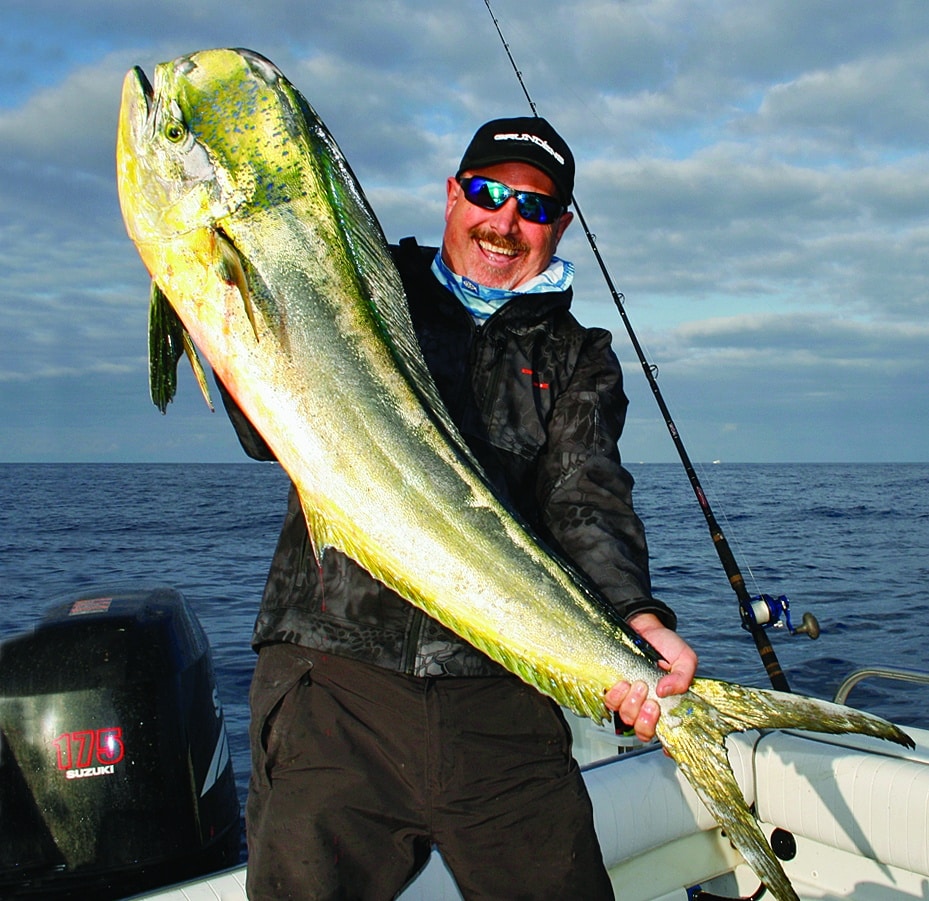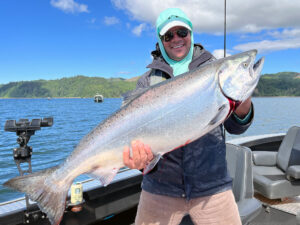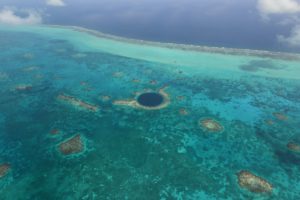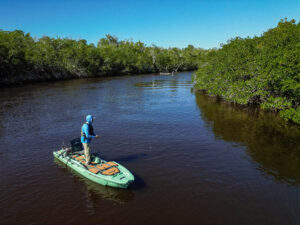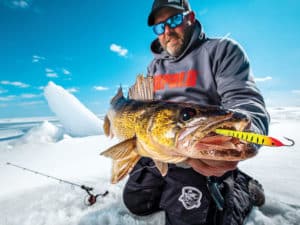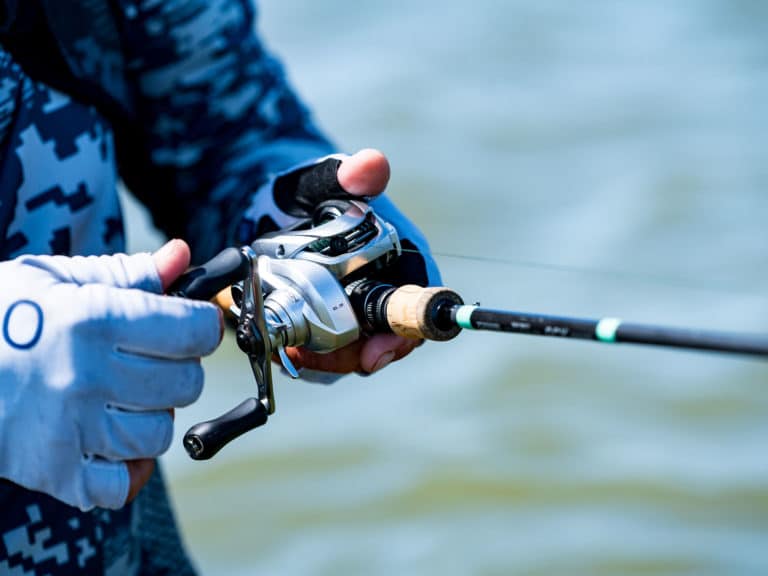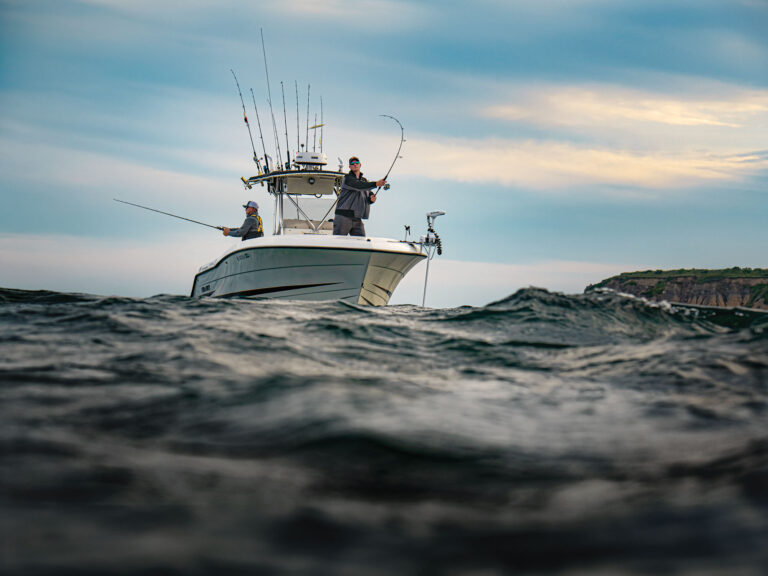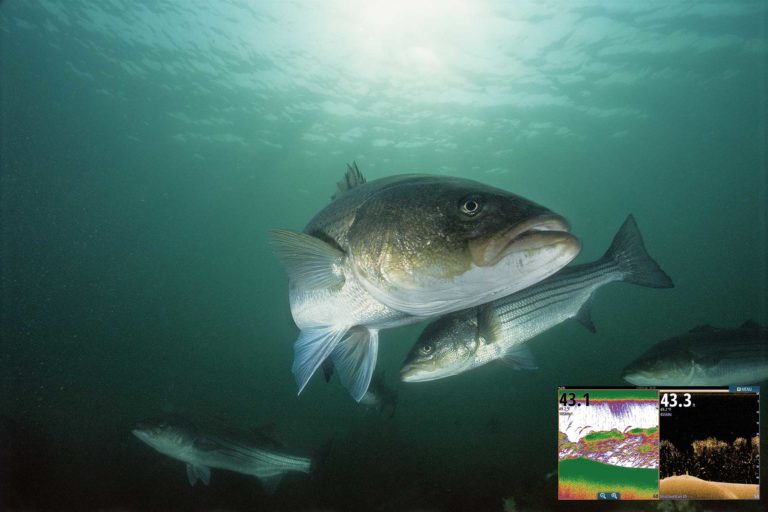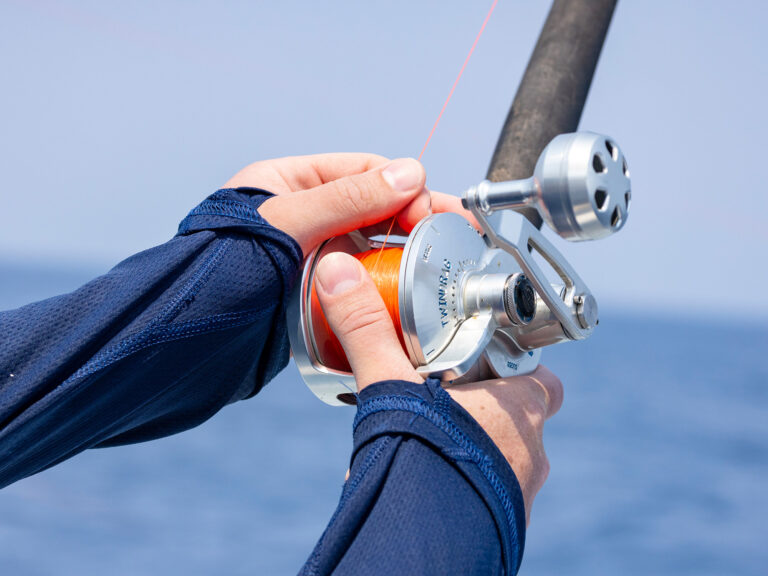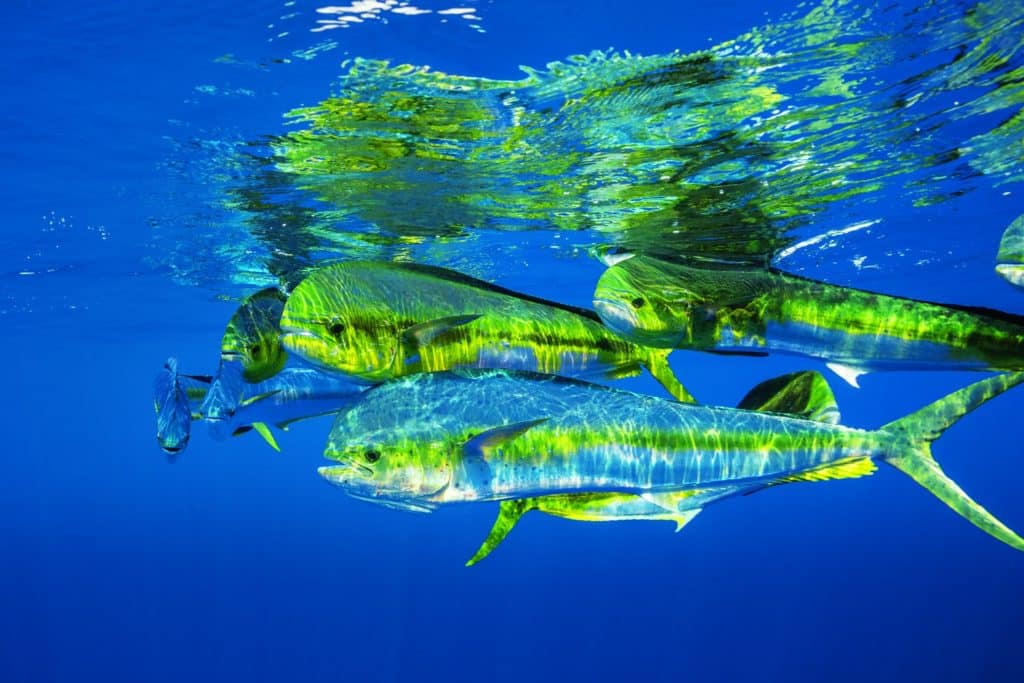
On most mornings, dawn over Newport Harbor in Southern California is a drab and gray affair, but this morning in the fall of 2015 was different. The usual marine layer had been replaced by scattered clouds and enough moisture in the air to turn the bay into a tropical paradise. Despite a bit of morning chill, the weather just didn’t feel right for early October. But then again, why should it? Nothing about Southern California’s weather or its fishing had been normal in quite some time.
As we made our way toward the harbor mouth aboard Capt. Jimmy Decker‘s Everglades 243, I couldn’t help but think how this trip was like many I’d made this year — a last-minute, seat-of-the-pants outing in pursuit of fish that had shown up in conditions never before experienced in this part of the Pacific.
This morning Decker and I would be involved in something that, after a lifetime of fishing Southern California waters, I never thought I’d be doing: trolling for wahoo. And we’d be doing it well within sight of the Fashion Island skyline in Newport Beach.
2015: The Year of the California Wahoo
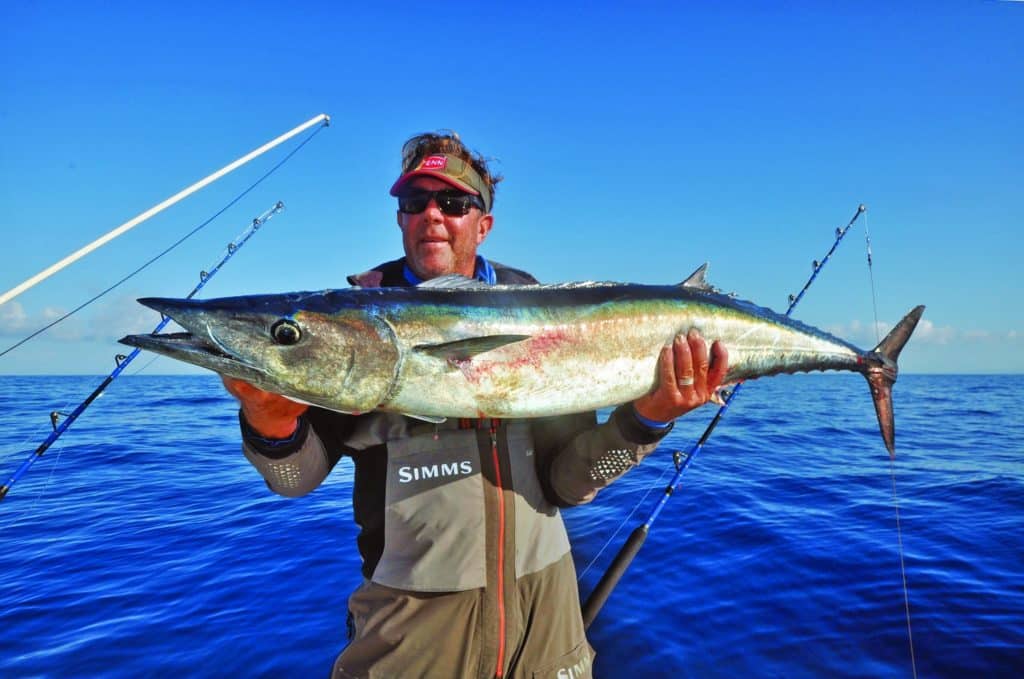
Before long, we started to see a few flying fish pop up and sail away from the boat. As I watched a bigger one soar off into the distance, I spotted a kelp paddy. When we drove past, Decker pointed out the brilliant hues of dorado. As soon as the outside jig passed the paddy, one of the rods loaded up, and a dorado broke the surface in flashes of gold and green.
After resetting our spread, we made another pass and were immediately bit again, but this time it wasn’t a dorado. Line melted off the spool quickly as Decker grabbed the rod. By the time I cleared the spread, the fish was a hundred yards away. The next few minutes were spent regaining line only to lose it again, but in shorter and shorter bursts, until we eventually stuck the gaff in the first wahoo that either of us had ever caught in California waters.
As it turned out, many anglers ended up catching their first “local” wahoo over the next few weeks, when fishing proved nothing short of amazing. By late October, 243 wahoo had been landed by sport-fishing boats in California waters. All the more amazing was the average size of these fish: 40 to 60 pounds was the norm, and 80-pounders were common. The biggest wahoo score came aboard the charter boat Legend out of H&M Landing, where 10 anglers targeting wahoo tallied 29 wahoo on a three-quarter-day trip. Even with such catches, private boaters probably accounted for 10 times as many of the giant mackerel as the sport boats. October 2015 will go down in history as the month of the California wahoo.
A New Fishery for Blue Marlin
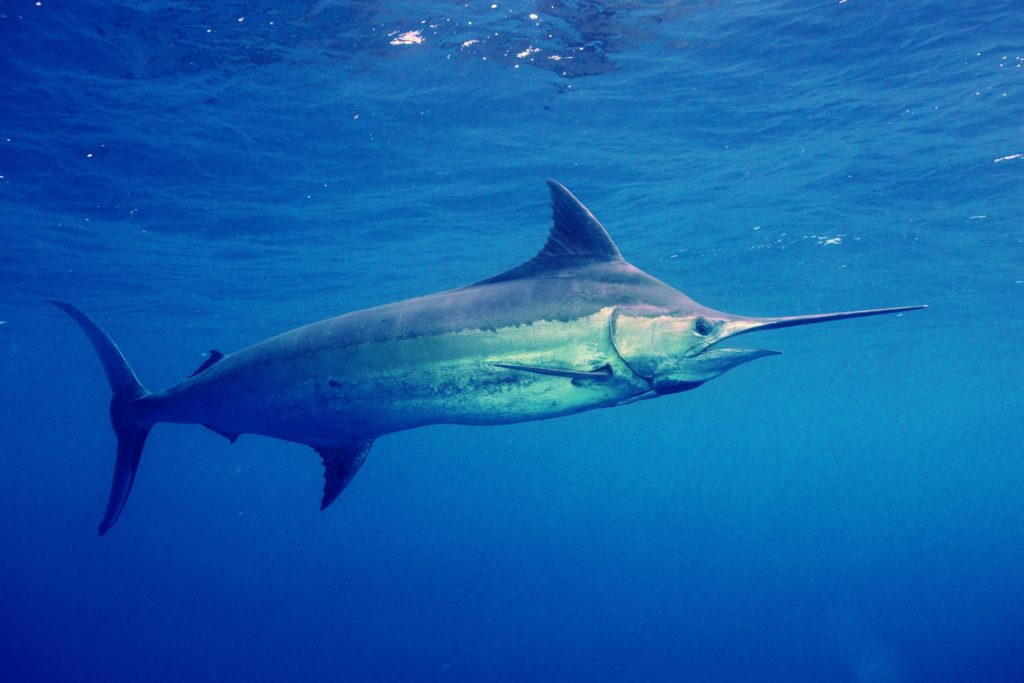
After the requisite high-fives and photos of our fish, Decker slid the 45-pounder into the fish box and said, “We’ve still got an hour and a half before the 11 a.m. high tide. What do you say we run out to the Avalon Bank and try to catch a blue marlin?”
The idea of trolling for blue marlin in Southern California waters would have sounded crazy to me before 2015. But on that morning it made perfect sense, so I answered, “Sure, why not?”
“There have been blue marlin caught in [continental] U.S. waters in the past,” explains Greg Stotesbury, sales manager for AFTCO, “but until 2015, there really haven’t been enough of them around to target effectively. The fish were available in our waters for several months leading up to the September full moon, when we enjoyed the best action.
“A lot of fish were caught during that week,” Stotesbury says, “and several 600-plus-pound blues were brought to the scales. On September 26, my friend Aaron Gross caught a 618-pound marlin on his 24-foot Skipjack, High Tide. The next day it was my crew’s turn: We got a 430-pounder on my 25-foot Skipjack, KawaKawa. Both of those fish were caught within a few miles of the beach, between Dana Point and Oceanside.”
SoCal Striped Marlin: As Good as It Gets
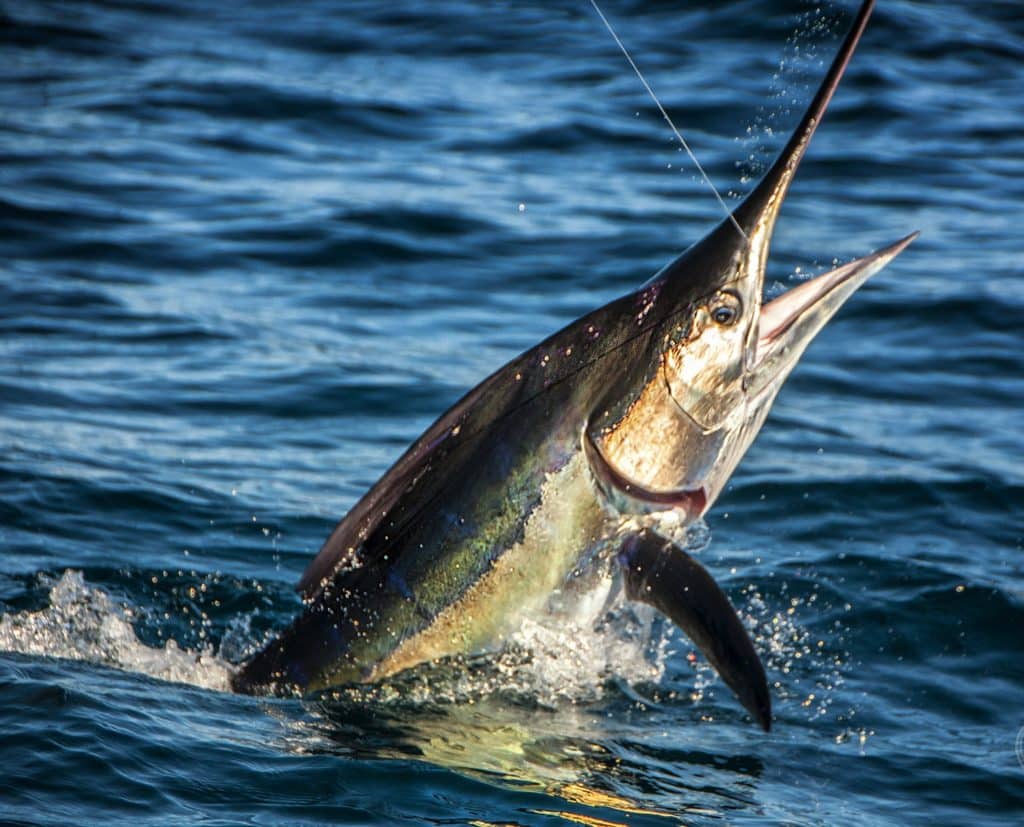
In fall 2015, pros like Stotesbury noted that marlin spread out and even continued their march northward. In midautumn, Stotesbury says, “There [were] blue marlin as far north as the Channel Islands. We fished up there the second weekend in October and released a 200-pound-class blue that we hooked while running to the anchorage at Santa Cruz Island.”
But it wasn’t just about blues. Aside from producing the occasional blue marlin, the northerly waters off Anacapa and Santa Cruz islands produced the best striped marlin fishing that anyone has seen in California — ever.
“The striped marlin fishing up there was as good as it gets,” Stotesbury confirms. “Last weekend we had 11 releases and are approaching 50 stripes for the season on our boat. There were so many fish that you could just drift and fish baits on the kite or fly line. There have been times when boats had as many as five fish hooked at a time.”
Multiple Phenomena Warm the Pacific
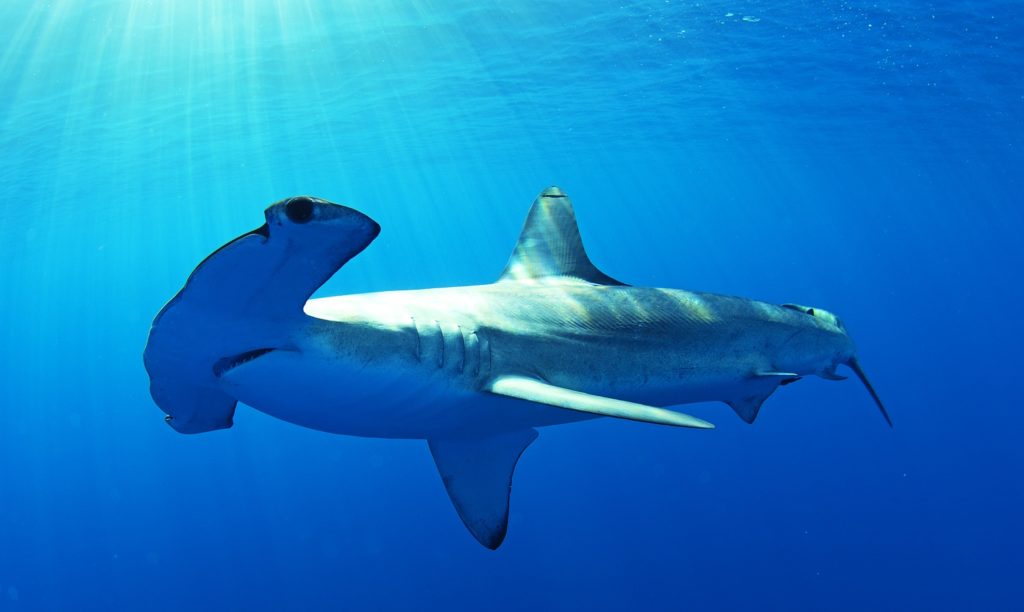
The wahoo bite off Orange County I enjoyed with Capt. Decker was one of many unprecedented phenomena during 2015 in the history of Southern California sport fishing.
Much of that amazing action was credited to El Niño by anglers and the media alike. But while there was an El Niño occurring, that alone doesn’t explain the chain of events leading up to all the newfound fisheries of that year.
Scientific consensus points to high-pressure ridging in the Gulf of Alaska as the real culprit, starting in the winter of 2012-2013 and re-establishing itself in the winters of 2013-2014 and 2014-2015. This unusual weather pattern disrupted the North Pacific storm track and, along with bringing a lasting drought to California, is believed to have led to the creation of the warm-water “Pacific blob.”
A meteorologist who calls himself the Fishing Weatherman, Chris Dunn has been watching developments in the Pacific for some time. The blob has become self-propagating, he says. “In very basic terms, the water temperatures off the California coast are controlled by a combination of currents and cold-water upwelling.
“In a normal year,” Dunn explains, “the water warms during the summer months, then cools when wind from winter storms causes upwelling. But over the last several years, the storm track hasn’t been lined up in a way that would do that. This lack of an active winter storm cycle has led to a lack of cold-water upwelling, so the water continued to warm and the blob continued to grow.”
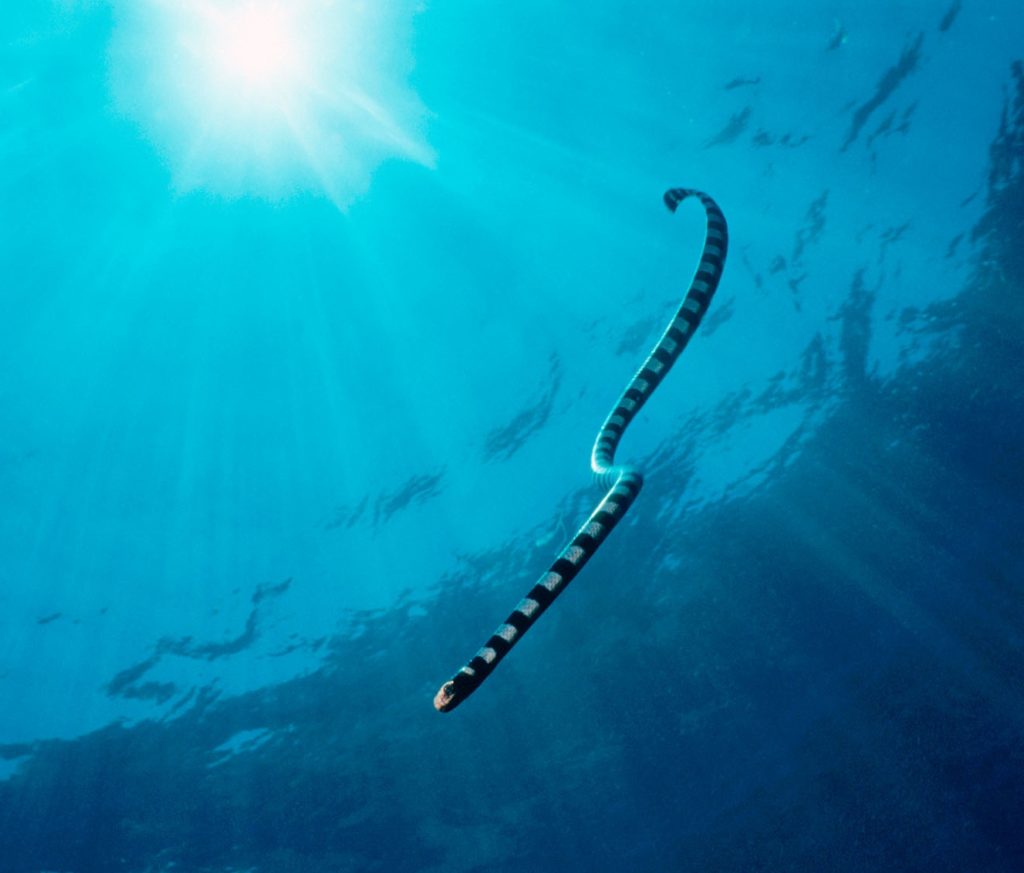
First detected in 2013, that blob has grown from a 500-mile-diameter zone in the Gulf of Alaska to now cover more than 2,000 miles off the coast from Mexico to Alaska.
To better understand the effects of the blob, Dunn offered a comparison. “I did a quick analysis of historical data from the ocean-water temperature at the San Clemente Basin buoy [about 42 nautical miles west of San Diego]. Over the 10-year period from 2004 to 2013, the average water temperature for the first few days of April remained between 59 and 60 degrees. In 2014, it was 62.6 degrees, and in 2015, 65.5 degrees. To put those temperatures into perspective, back in 2012 we didn’t hit that temperature mark until mid-July.”
Big Bluefin Break Lines and Hearts
That unusually warm water translated into some hot early-season offshore action for Southern California anglers, which I had the chance to experience while fishing with Decker in June. We’d run a mere 20 minutes from the harbor when Decker said, “We’re a little short of the 14-mile bank, but I’m going to drop the jigs in here.” He’d caught jumbo bluefin earlier at the same waypoint.
Those bluefin were among many schools of huge (for California) bluefin that seemingly showed up out of nowhere and left everyone wishing they’d brought heavier tackle. “Back in early June, there were spots of 30- to 40-pound bluefin and yellowfin popping up on anchovy schools around here. It was basically run-and-gun bird-school fishing [following feeding birds, in local parlance], and the tuna were only biting the jigs,” Decker says.
“One of the schools I pulled up on ended up being all 100- to 200-pound fish,” he adds. “I hooked one on the first cast with a Shimano Colt Sniper on my light jig stick. That fish immediately spooled me, so I grabbed my heaviest rod and tied on another jig. The whole time this was happening, the bluefin were blowing out so close to the boat that it sounded like I was fishing next to a waterfall. I ended up getting bit on the first cast again with the heavy gear, and never slowed that one down either. After that I pretty much gave up and went looking for some smaller fish to catch.”
Decker wasn’t the only one to run into this problem. Many reports poured in of lopsided battles between anglers and oversize bluefin tuna during the months of June and July, unheard of off Southern California until last summer.
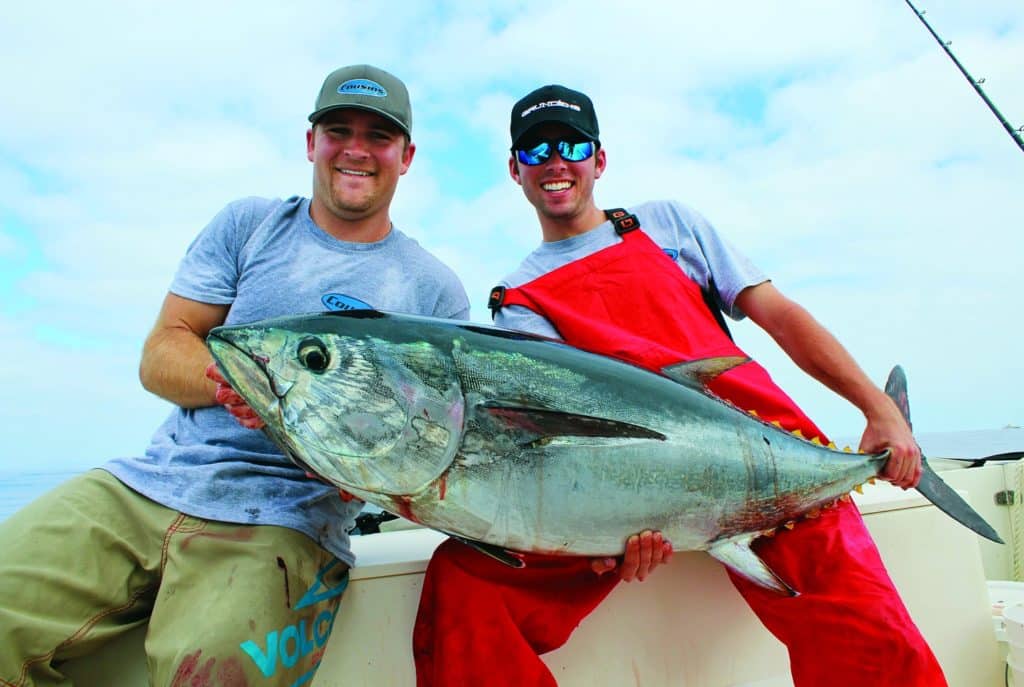
Tuna’s New Timetable
But even more unlikely, bluefin (if not all triple-digit fish) had originally showed up months earlier. Capt. Duane Mellor of Pinnacle Sportfishing was one of the first to get on these fish. On April 1, he ran into a school of them just a few miles off the coast of San Diego and landed 18 fish to 50 pounds while suffering losses on larger ones.
After spending the next several months targeting those fish, Mellor noted that they were acting very differently than bluefin tuna normally do in our waters. “The bluefin were keyed in on anchovies too small to use as bait,” he says, “and it was almost impossible to get one to bite a sardine. For the first few months, every single fish we caught came on the surface iron — light metal jigs like a Tady 45.
“To hook one, you had to cut way outside the school, shut down, wait for them to get into casting range, and then make a long cast to them. If you didn’t get bit in the first couple of turns of the handle, you weren’t going to get bit. And if you were lucky enough to get bit, you were going to be in for a battle if you hooked a bigger one. That first day, I hooked a good one on a 10-foot jig stick. It broke my rod after an hour and a half and came off just out of gaff range. It was brutal.”
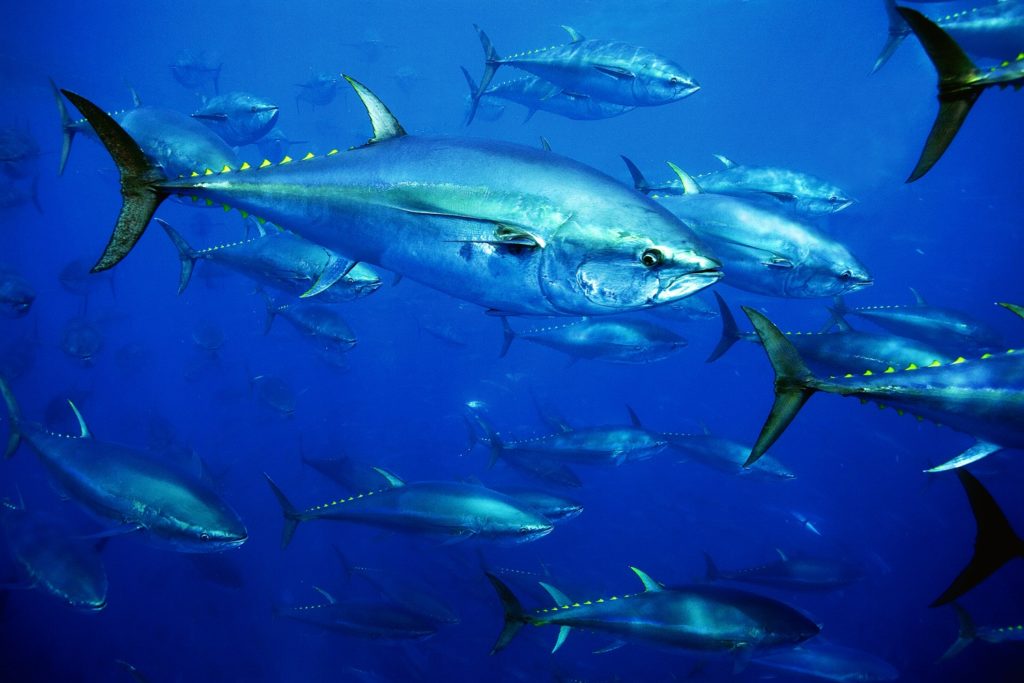
In time, anglers did figure out how to target these bluefin with proper tackle, and the stories changed from the agony of defeat to the thrill of catching the fish of a lifetime. “The biggest hurdle was getting them to eat a live bait,” explains Stotesbury. “We started out using small two-speed reels full of 65-pound braid, with a short 50-pound fluorocarbon leader to fish mackerel. The tuna were boat-shy, so we’d have to keep the boat a good distance away from the school and long-soak the baits [let them drift back to the tuna]. That worked to an extent, but we were still losing some really big fish. Eventually we transitioned into fishing the kite and were finally able to hook these tuna on the right gear.”
Looking back at the amazing year for sport fishermen off Southern California, one can’t help but have high hopes. While no one, scientists included, can truly prognosticate water temperatures for 2016, it seems that anglers are justified in hoping for another crazy and exciting year.
Was 2015 the New Normal for Southern California Fishing?
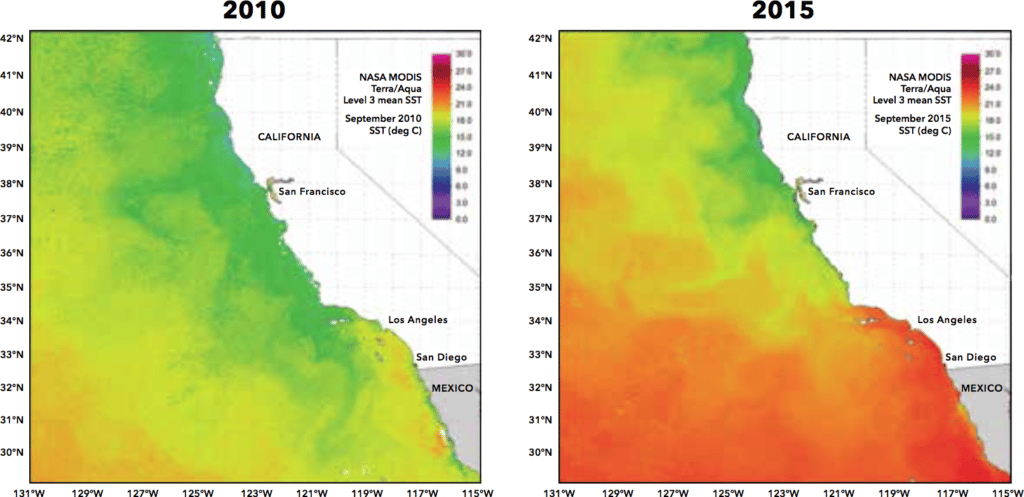
With everyone shouting about El Niño, it’s easy enough to chalk up this year’s incredible fishing as a byproduct of that equatorial weather pattern. But meteorologist Jan Null, of Golden Gate Weather Service, disagrees.
“There continues to be the misconception that because El Niño has something to do with warmer-than-normal water somewhere in the Pacific, and the waters along the California coast are warmer than normal, then they must be related,” Null says. ”They’re not! The current warm-water anomalies along the California coast first showed up in February 2014, but the tropical Pacific didn’t reach minimal El Niño strength until November 2014.”
So what does this mean for the fishermen? According to marine biologist Lyall Bellquist of the Scripps Institute of Oceanography in La Jolla, California, El Niño might not affect the fishing as much as you’d think. “One thing we learned in 2014 was that you don’t necessarily need to have a high El Niño index to experience similar sea-surface temperatures and excellent offshore fishing,” Bellquist says. “But 2013 and 2014 were unprecedented in terms of species, sizes, and proximity to shore without any El Niño influence. There’s a decent chance that, because our current El Niño arrived in the fall of 2015, it could stretch the excellent fishing deep into winter. Storms associated with El Niño, however, could mix things up a bit.”
Uncertainty about those winter storms is a major reason weather experts like meteorologist Chris Dunn keep from making a prediction for 2016. “Because there are a number of variables that control water temperature and the movement of migratory fish, it’s tough to say if we’ll see a ‘three-peat’ continuing the last couple of years.
“Oceans take quite a while to heat up and cool down, so it would take a drastic change of events to kick things back to what is considered normal in just one season,” Dunn says. “The bottom line is that this season’s fishing may have been the peak, and with a more active storm track this winter, I’d expect to see our water temps a little closer to normal next year. Will we see wahoo on three-quarter-day trips? That might never happen again in our lifetimes. But who would ever have believed such a thing was possible in the first place?”
A Changing Fishery — Looking at the Data

Analysis: In looking at catch data from 2013 and 2014, the transition from a cold- to warm-water cycle is evident with an increase in yellowfin and a decrease in bluefin landings. In 2015, the yellowfin and bluefin tuna counts were both down from the previous year, but the average size of the fish was significantly larger. Bluefin also extended their range to provide anglers as far north as the Bay Area some unexpected and, by midautumn, surprisingly consistent fishing.
Throughout most of the year, catches of both species averaged 30 to 40 pounds, with much larger fish being caught regularly. The yellowtail numbers have remained steady over the last three years, but the average size of the fish has increased dramatically. During a normal year, the bulk of the yellowtail catch comprises fish under 15 pounds, but starting in the autumn 2014 and continuing through 2015, the average yellowtail size was 20 to 25 pounds. Catches of dorado increased right alongside the wahoo catches in 2014 and 2015 as two years of unusually warm water shifted their ranges north into California waters.
